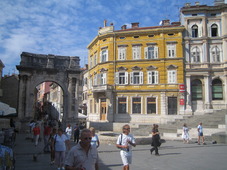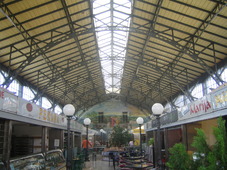to enlarge


or choose the place
from the menu below
 Rome |
 Byzantium |
 Venice |
 Vienna |
 Brioni |
 Smrikve |
 |
 |
The Triumphal Arch signifying victory was erected not long after this event, probably between 25 BC and 10 BC. The 8 meter high Arch is simple and well proportioned. The pilasters are divided on each side by two thin grooved Corinthian half columns richly adorned with relief decorations. It has both Augustus and Greek architectural elements.
Vertical parts of the Arch are decorated with relief motifs of grapevines while its centre depicts a scene of an eagle fighting a snake. Two flying Victories, the divinities of victory, stand between the inner half columns near to the top of the vault.
Above the cornice rest the stone pedestals where the sculptures of the three members of the Sergi family were laid with inscriptions. The sculptures have not been preserved.
It is interesting to note that at the time this monument was located inside the town walls. The Golden Gate stood at the eastern side of the building. This is the reason why the western side of the Arch is much more decorated.
Since the town walls and the Golden Gate itself were demolished in the 19th century today we see the Triumphal Arch as a self standing monument, but originally it was part of the town gates. The Golden Gate had three arches. The central one was bigger and was used for wagons, while the two side ones were used by people.
Another very interesting fact is that the French Museum Wicar in Lilla still preserves the original design of this Arch made by the famous Renaissance artist Michelangelo Buonarroti (or Sangallo).
Michelangelo (or Sangallo) came to Pula to study the static design of this gate. He studied the Arch and some other important Roman monuments in the town that he later applied to Renaissance architectural developments.
 Very close to the Triumphal Arch of the Sergi, on the right side of the Arch, is the
house where James Joyce once lived. James Joyce lived in Pula for just a few months and he did not like the
experience.
Very close to the Triumphal Arch of the Sergi, on the right side of the Arch, is the
house where James Joyce once lived. James Joyce lived in Pula for just a few months and he did not like the
experience.
Dante Alighieri also visited Pula and was so impressed by the oldest Istrian prehistoric necropolis that he wrote about it in The Divine Comedy.
Dante visited Pula when Pula mostly had just a memory to offer, as many centuries had gone by since its glorious past. According to some sources Dante was in Pula in 1320 during his exile and he was the guest of the Abbey of St. Michael located on a Mount. The Abbey no longer exists since the Austrians decided to demolish it in 1851 and to build the fortress named St. Michael.
Among the demolished parts of the Abbey was also found the tombstone of the Hungarian King Salomon. One piece that has been conserved from this old building is a beautiful stone doorway that you can see on the southern part of Pula’s Cathedral, which dates back to 1457.
If you pass the Golden Gate you will enter Sergi Street, that is one of the most important streets in Pula’s Old Town.
 Before you enter the Old Town I recommend that you to visit a few more interesting artworks
from the Austro-Hungarian period.
Before you enter the Old Town I recommend that you to visit a few more interesting artworks
from the Austro-Hungarian period.
Just take the street opposite to Via Sergi and after few hundred meters you will reach a small square. In that square on your right-hand side you will see a big steel building structure.
This is Pula’s famous market. The market was built in 1903 based on the plans of the great Engineer L. Nobis. It’s Art Nouveau style is an architectural attraction in Pula.